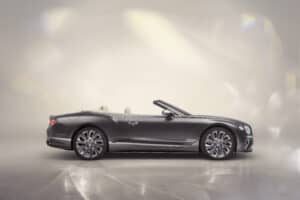Daniel Walford and his father John are classic car enthusiasts of note. Their appetite for finding neglected cars and bringing them back to their former glory has been their passion for over 40 years.

On a dark, dank day in early 2013 Daniel and John were scanning the car magazines for their next project when the spotted an Aston Martin which had been left to rot in a local barn, not far from their home in Kent. It was typical of the type of car this duo love to renovate. It had spent years abandoned, on chocks, under a large tarpaulin and been virtually forgotten. The car was cover in algae and was rather rusted but to Daniel and John she was perfect. I say “she” as this Aston Martin DB2/4 Mark 1 was affectionately renamed “Gloria” by the pair, during her renovation.
Once in their garage, work began stripping her down so that they could begin the long process of bring her back to life again. Daniel worked for Lister Jaguar FIA GT race team as a fabricator and engineer (he was part of the World Championship winning team in from 1999 to 2001) so is a very experienced sports car mechanic. Added to which, the duo had revived on over a dozen Aston Martins, so were rather surprised when they began to notice some unusual and interesting modifications. The Aston Martin had reinforced steel bumpers, a heavy-duty anti-interference ignition system, driver’s seat connections for a two-way radio, as well as a gadget which accurately computed time and distance in relation to a pre-selected average speed. For a car built during the early 1950s these features where not only unusual but would also have been considered to be state-of-the-art for their time.
In fact the car was so unusual that Daniel Walford began researching the car’s history and what he discovered was surprising to say the least. Now, Donald and John Walford firmly believe that their DB2/4 Mk1 was the inspiration for James Bond’s Aston Martin.

In Ian Fleming’s seventh novel ‘Goldfinger’, James Bond takes delivery of a DB 2/4 Mk3. Until now, most people had thought that the modifications in James Bond’s car were purely a figment of Fleming’s vivid imagination, however, many of the features that the Walfords discovered also feature in Bond’s Aston Martin in the book. From hidden compartments to a homing device the similarities were astonishing. (Although the Walford’s car did not have an ejector seat!)
Nobody knew why Fleming had changed his hero’s car from a Bentley, in his early books, to an Aston Martin DB2/4, especially since Fleming did not own either. He was known to be a keen motor sports enthusiast, having raced international rallies with Donald Healey of Austin Healey fame, yet Fleming had chosen an Aston Martin for his hero. It may be that the Walford’s ‘barn find’ held the answers.
The car was originally built for Squadron Leader The Hon. Philip Ingram Cunliffe-Lister. Ingram, as he was known, was a WWII spitfire pilot who had a passion for motor racing. He was also the son of Lord Swinton, who has long been considered to be the man on whom the fictional character of ‘M’ was based. Swinton, like M, was the head of MI5, MI6 and the SIS (Secret Intelligence Service) during the war years, he was also Ian Fleming’s boss.
Ian Fleming was the roguish younger son of a British MP, Valentine Fleming; heir to the Robert Fleming & Co Merchant Bank. Ian’s father died when he was 9 years old, leaving him a substantial trust fund which supported his love of living the high life in flamboyant manner. Ian was often seen frequenting many of the gentlemen’s clubs and society events which were popular with the well healed and aristocratic young gentlemen of the 40s and 50s. Ingram, 8 years his junior, was an aristocrat, a dashing and charismatic war hero who shared Fleming’s passions for cars and racing, he would certainly have been at similar events and places as Fleming. However, simply moving in the same circles was not enough of a link to demonstrate that the Walford’s car was the one which inspired Ian Fleming to use it in his novels.
By the time he began to write his famous spy stories, Ian Fleming had married, moved to Kent, and was leading a much more quiet and sedentary existence. Fleming always wrote from fact and experience with a fair dollop of artistic licence. For example, his next door neighbours, while he was living in St Margaret’s Bay near Deal in Kent, were Dennis and Rose Ramsay. Fleming famously used the Ramsay’s house as inspiration for the home of his character Hugo Drax in his 3rd book, Moonraker.
The Ramsays were godparents to Ingram Cunliffe-Lister’s younger son and Ingram used to visit them regularly. In the sleepy Kentish villages of the mid 1950s it would be almost impossible not to notice his state of the art Aston Martin arrive.
Given the family connections and Fleming’s relationship with the Ramsays it is highly likely that Ingram and Ian were also friends. During the restoration, (Philip) Ingram Cunliffe-Lister’s son came to see the work in progress, relaying many happy childhood stories of road trips he had had with his father in the car. Alas Ingram died in 1956 at the age of 38.
Daniel and John Walford spent over 18 months bringing the car they named “Gloria” back to life. As you can see, their efforts have ensured that she lives up to her name. The car was sold, privately at auction earlier this year, along with a pack containing the history of the car, receipts from the 60s and 70s as well as the story about the many connections the car has to that of legendary car belonging to James Bond.
If you would like to see our range of classic or modern Aston Martins, our sales team would be delighted to discuss them with you.







